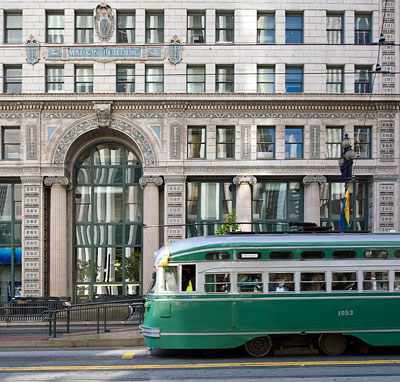National Register of Historic Places in San Francisco
Matson Building and Annex
215 Market Street
Built 1923, 1947, 1958
The sixteen story Matson Building, designed by Bliss & Faville and built between 1922 and 1924, is one of a series of Chicago School skyscrapers built during the 1910s and 1920s which give San Francisco its downtown character.
The Matson Building closes a grand view down Pine Street and pairs admirably with the adjacent Pacific Gas and Electric General Office Building.
The Matson Building is a very fine example of the tall office building designed as a column. The arcaded, four-story capital is rich in omamanetation, contrasting with the quietly rusticated nine central stories of shaft. The rich four-story base repeats the proportions of the top with three-story columns and a fourth intermediary story interrupted by the central entry arch.
The fine terra cotta detailing is typical of Bliss and Faville. They sheathed the main elevations in a cream colored terra cotta with a somewhat reflective sheen. A second color, turquoise blue-green, was used on certain blocks to provide a background tone or to emphasize relief. They designed custom ornamental details to symbolize the building's owner and chief occupant, the Matson Navigation Company, a leading freight and passenger carrier between the West Coast and Hawaii.
The Matson Building was enlarged in 1945-1947. The addition duplicated both the exterior and interior of the original building and is fully interconnected with the main structure.
Excerpted from the NRHP nomination dated 23 October 1995.

Of the half dozen steamship companies which provided regular service from San Francisco to Hawaii between the world wars, Matson stood first in quantity of business produced by its four luxury liners and 30-odd frighters specializing in Hawaiian shipping.
The approach of war in 1940 brought enormous change to the Matson company. In 1940 the luxury liners Monterey and Mariposa were ordered to evacuate American families from dangerous sites in Asia. By 1941 the company was transporting essential materials, such as wool, from New Zealand and Australia to the United States. Between 1941 and 1946 Matson operated in addition to its own fleet some 127 ships, more than triple the size of its pre-war fleet. Matson Terminals processed at least ten million tons of wartime cargo. Four of the company's largest passenger liners were converted to troop ships, making 119 voyages and carrying 736,000 passengers. World War II was the high water mark of Matson operations.
So extensive were the company's responsibilities at the close of the war that management ordered construction of the Annex, designed to rise to the original block's height, but constructed in 1945-1947 to eight stories.
In addition to investment in its headquarters building, enormous amounts of capital were required to refit Matson's vessels to peacetime uses. After the war, Matosn lost passenger service to air transportation, and freight shipping also changed drastically. Matson sold its Hawaiian hotels and the Matson Building in 1959, and it ceased passenger service in 1970.
The Matson Building and Annex represent the company's best years.
